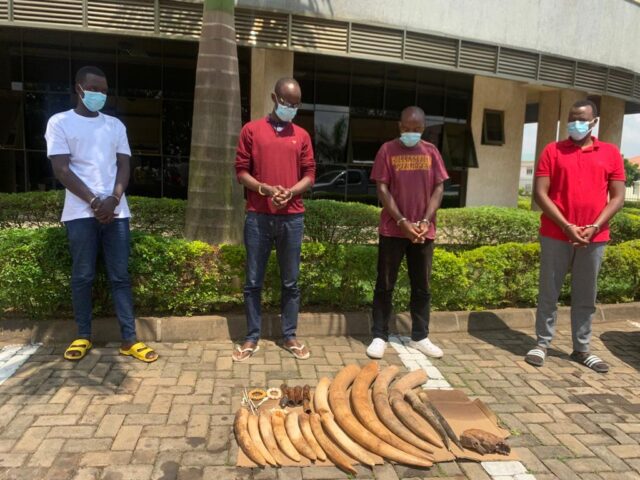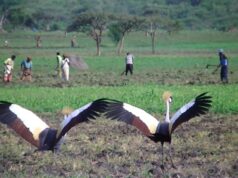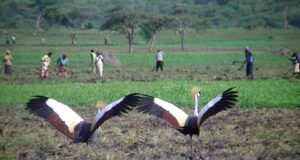
By Kelly Rwamapera
All ivory trafficking cases in Rwanda involve cross-border smuggling from especially Tanzania and the Democratic Republic of Congo (DRC).
The central African country on the edge of eastern Africa has just over a hundred elephants, a population so easy to manage and monitor in one of the smallest savannah parks in the region, the Akagera Park.
Rwanda’s stockpile data shows that the year 2016 marked an unusual increment in ivory trafficking in Rwanda, while Tanzania was experiencing a decrease in ivory trafficking at the time.
The Rwanda Development Board (RDB) has not shared with Intego News any information we requested on ivory trafficking apart from sending us back and forth between the communications office and the conservation analyst’s office.
Non-government organisations in wildlife conservation told us that they knew nothing about Rwanda’s wildlife stockpiles and that it was not part of their partnership with RDB.
“We don’t have access to the national stockpiles. Our work is to turn poachers into protectors. But when it comes to stockpiles, it is the RDB that knows” Ange Imanishimwe, the Executive Director at BIOCOOR, a local non-government Organisation advocating for biodiversity conservation told Intego News on 29 July 2024.
Rwanda’s stockpiles 2008-2016
Analysis of the available data proves that Rwanda could become an ivory transit between East and Central Africa.
RDB, the managers of the wildlife stockpiles, reported in 2016 that in eight years (between 2008 and 2016), authorities seized 18 ivory tusks from traffickers in Rwanda.
Protais Niyigaba, the Nyungwe Park Manager, told Intego News that authorities destroyed some 150 kilograms of ivory out of the 350 kilograms in Rwandan’s wildlife stockpiles.
We can conclude that there were 200 kilograms of ivory in Rwanda’s stockpiles in mid-2016.
But how do we prove that the 18 ivory tusks weighed 350 kilograms, as the RDB reported in 2016?
Most ivory tusks are for female elephants and weigh between 18 and 20 kilograms, meaning that the 18 tusks weigh between 324 and 360, a range that accommodates the 350 kilograms that authorities reported.
Intego News has also established that after the destruction of 150 kilograms in late 2016, authorities seized about 200 kilograms of ivory from four residents of the Kirehe border community with Tanzania and other non-nationals.
Thus, by the end of 2016, there were 400 kilograms of ivory in national stockpiles.
Dividing the 400 kilograms by the eight years of ivory seizures (between 2008 and 2016), the annual average seizure becomes 50 kilograms.
In conclusion, the country seized 400 kilograms of ivory between 2008 and 2016, at a rate of 50 kilograms per year.
Rwanda’s stockpiles 2018-2023
Rwanda Investigation Bureau (RIB) reported in early 2024 that it had seized 104 ivory tusks in five years between 2018 and 2023.
The change from 18 ivory tusks seized in eight years to 104 ivory tusks seized in five years shows both seizures and the amount of ivory trafficked through Rwanda increased.
Using the standard we applied to verify the weight of the 18 ivory tusks (that an ivory tusk weighs 18-20 kilograms), the 104 ivory tusks the RIB reported for 2018-2023 weigh between 1,872 kilograms and 2,080 kilograms, other factors remaining constant.
If ivory accumulated between 2018 and 2023 weighed 1,872 and 2,080, we can establish that the annual average seizure was between 374 and 416 kilograms.
Conclusion on ivory stockpiles
Ivory flow into Rwanda increased since 2016 from 50 kilograms per year between 2008 and 2016 to an average of 374 and 416 kilograms per year between 2018 and 2023.
We submitted the above findings to RDB for comment.
Theresphore Ngoga, a conservation analyst at RDB, blamed us for asking him instead of the communications office that had also sent us to him not once.
This increased ivory trafficking in Rwanda corresponds with Tanzania’s crackdown on ivory trafficking since 2014, destroying ivory trafficking channels and routes and making unlikely routes like Rwanda become an option in the years that followed.
A 2020 report by the Environmental Investigation Agency (EIA) confirmed that ivory trafficking was increasing in central Africa as it dropped in Tanzania from nearly 5.5 average tonnes per year between 1998 and 2014 to one average ton per year between 2015 and 2019.
Stockpile leakage fears
The United Nations Office on Drug and Crime (UNODC) sheds fears on the mismanagement of stockpiles as a central fuel of wildlife crime, enabling chances of stealing seized trophies into trafficking channels.
The World Wildlife Crime Report 2024 cited vulnerability in several countries such as Viet Nam, Malaysia, Madagascar and Rwanda’s neighbor Burundi.
According to the Convention on International Trade in Endangered Species of Wild Fauna and Flora (CITES), stockpiles should be tracked by concerned parties and destroyed regularly to avoid the cost of management, according to its Guidance Document on Ensuring Effective Stockpile Management.
“Given the often burdensome costs, risks and responsibilities associated with securing stockpiles of such value, some countries choose the option of regular destruction. There are circumstances under which destruction of stocks should never be considered, especially those specimens that constitute evidence in pending court cases.” the document said in part.
This story was produced in partnership with InfoNile with funding from the Earth Journalism Network. A journalist from Vietnam who requested anonymity to protect their safety contributed reporting from East Asia.













